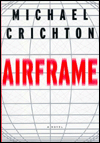
Airframe
by Michael Crichton
Review by Sean Doorly
A friend of mine who noticed I was reading Michael Crichton's new book "Airframe," said, "Why does everyone like him -- his characters are so wooden and, well, the writing isn't the greatest."
It's true Crichton's characters are a little thin, but you don't read his books for characterization. My Dad gave me "Andromeda Strain" when I was a teenager. He liked it and thought I might also, because, like many teenage boys, I was "into" science fiction. I loved it and sought out all the other books Crichton had written -- even the non-fiction ones. (For the record, his memoir, "Travels," is my favorite.)
With Crichton, it's the plots that make me come back again and again. He hooks you from page one. Many times I read his novels in one sitting.
Crichton's genius is that he knows how to boil down a complex subject for us normal folk. He actually makes computer charts and graphs both exciting and integral to the story.
But his biggest accomplishment is the "awe factor." He takes you places you've never been but might want to go to. In "Jurassic Park," he laid out his theories so well that, I believe one day I might be gawking at a T-Rex behind a 50 foot electric fence.
"Airframe" opens with Trans Pacific Airlines Flight 545 climbing and diving violently. The plane, a Norton N22, finally lands in Los Angeles but 56 passengers are injured and three are killed.
Cut to Norton Aircraft employee Casey Singelton, who is called on to investigate the incident. Casey's investigation is important because there is an impending $8 billion sale of 50 N-22's to China.
Norton Aircraft's entire future depends on the outcome of her investigation. If that isn't enough pressure for Casey, Crichton throws in union saboteurs, company spies and an investigative new show Newsline ready to tell the world that N-22's are deathtraps. Casey is Crichton's first female hero. She's tough, smart and doesn't give up even when all looks impossible. (I'd be curious to see if Crichton uses another female lead in his next novel.)
Who would have thought there was so much drama in an airplane factory? "Fifteen aircraft in various stages of construction were arranged in two long rows under the vaulted roof... Beyond the fuselage stood a forest of assembly jigs -- immense tools, painted bright blue. Richman walked under one of the jigs and looked up, openmouthed. It was as wide as a house and six stories tall."
Crichton packs in a ton of information -- sometimes too much. The characters break into lecture mode and tell you all the details of FAA regulation, the black boxes and TV vs. print journalism. These details "usually" detract from the story but you have to read them because a few plot points are buried in the jargon. I say "usually" because Crichton is the only author I know who can make technical jargon understandable and I did learn a few things from these lectures. "Since air moves faster across the top of the wing it creates a vacuum which sucks the wing upward. The wing is strong enough to support the fuselage, so the whole plane is lifted up. That's what makes a plane fly."
Like all of his previous novels, Airframe is being made into a movie. There are a few showstoppers in the novel that will translate well onto the screen: the opening scene, a chase through the humongous airplane hangars at Norton, and the climatic test flight.
After devouring Airframe, I'm waiting patiently for his next novel. I wonder what it will be about -- the Internet, terrorists, the space program? Do you have any suggestions? If so send them to Bookpage. And then maybe we can send them off to Crichton -- or you can just pay attention to the headlines. I'm sure Crichton is.